
|
Whiteboard Rooms
for
Mathematics Instruction
|
|
|
It has been documented that typical mathematicians work on vertical, erasable surfaces, aka blackboards or whiteboards, particularly when collaborating on research. We should ask our students to work in the same way.

|
|
|
The basics
The room
Erasable boards mounted on all available wall space.
Standard, 1.2m high whiteboards, whiteboard wall paper or whiteboard paint floor-to-ceiling, are configurations that have been successfully installed. Boards can also be mounted in front of low windows.
The ideal space:
A square room, all four walls covered with boards, no furniture (maybe some stools), no identifiable "front".
Budget range: $450 - $15,000
Standard 1.2m high whiteboards for a 7m x 7m room cost $2,500-$3,000 (plus installation).
The cost depends on how much you can spend, what you are hoping it will look like and the quality with which you are willing to work.
On-going costs per year are about $600 total, including whiteboard markers, erasers and cleaning fluid. This can be reduced if students are asked to supply their own whiteboard markers--with the teacher having an emergency supply for those who forget (who are also required to clean all the boards with cleaning fluid each day they forget).
|
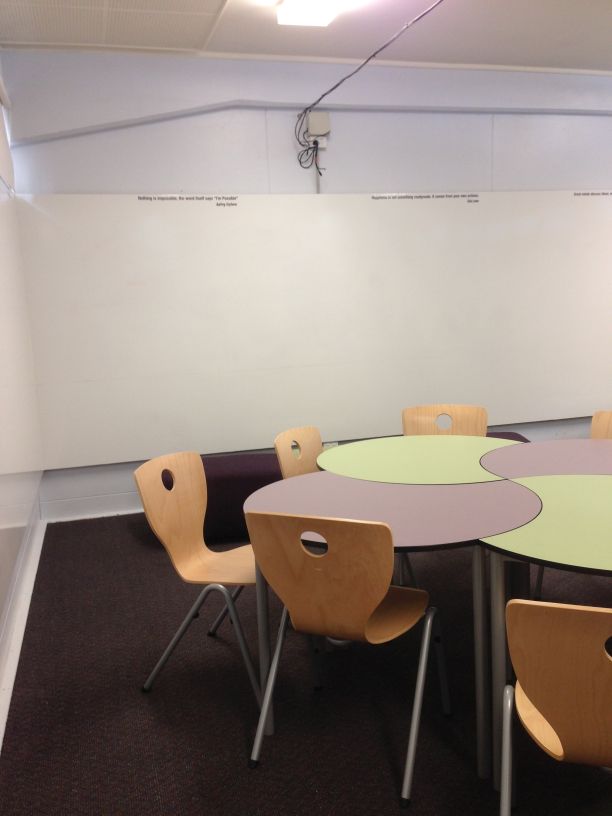
|
|
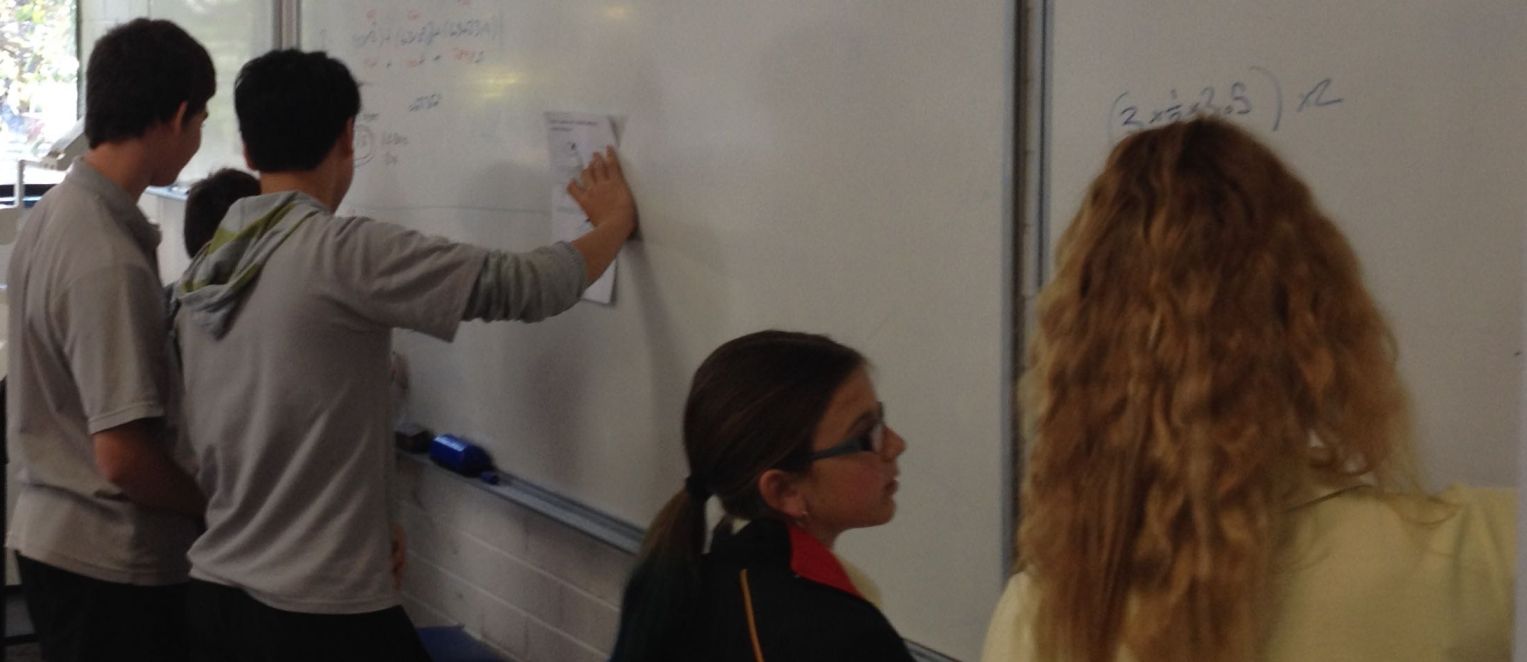
|
The students
Students attempt questions and problems on the boards.
Students can be asked to work in pairs, in small groups or individually.
Looking at other student work and discussions about the task are encouraged.
|
|
The teacher
While students are working, move from student to student answering questions, clarifying problems and identifying misconceptions.
The teacher can easily call the attention of part of the class or the entire class if there appears to be a common misconception.
|
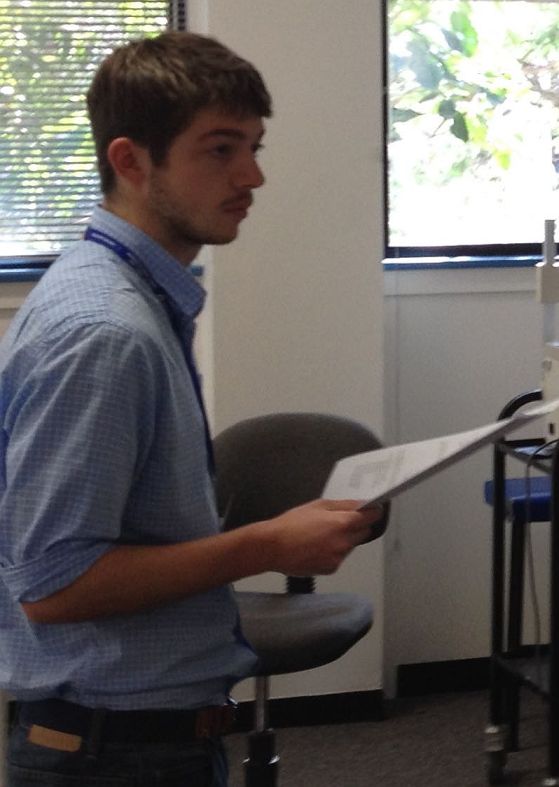
|
|
|
|
|
Advantages

|
Visible learning: The student and teacher can very easily see student understanding of the content as students work on problems and questions--the phrase "viewing what's inside the student's mind" has been used in reference to working in the room.
|

|
Natural Collaboration: The environment lends itself naturally to student collaboration as they can view each others' work and discuss their solutions. This is particularly the case when students have been paired or divided into groups.
|

|
Engaged students: Early research suggests that students remain engaged and on-task more readily in a whiteboard room than in a normal desk room undertaking activities that are intended to be engaging.1
|

|
Formative assessment: Given the ease with which the teacher can see student output, this allows the teacher to constantly monitor student learning and adapt lessons and activities appropriately to address shortcomings.
|

|
Student-centered: For much of the class, the students' work is on show and at the centre of discussion. Furthermore, collaboration becomes the norm, removing the teacher from the centre of attention.
|

|
Risk-free for students: Students are more likely to attempt a problem, initiate working or create a diagram of the problem if they know it can be fixed or erased and redone easily.2
|
|
|
|
|
The rise of the CLOWD Room
Scenario
In 2014, twenty-four Year 8 students and twenty-five Year 9 students from a local high school attended UOW for two "Work Like a Mathematician" excursions each group. Each excursion consisted of two lessons and either a tour of the UOW Wollongong campus or a visit to a mathematics lecture. The two lessons were delivered by students in the subject MATH270, a subject that aims to give non-education students a taste of teaching. One lesson was delivered in a normal classroom and the brief given to the MATH270 students was to make the activities engaging, hands-on, exciting. The second lesson was delivered in a whiteboard room and the brief given to the MATH270 students was to prepare a sheet of mathematics problems. Given the size of the room at UOW, the high school students were divided into two groups with one group in each room, swapping for the second lesson.
|
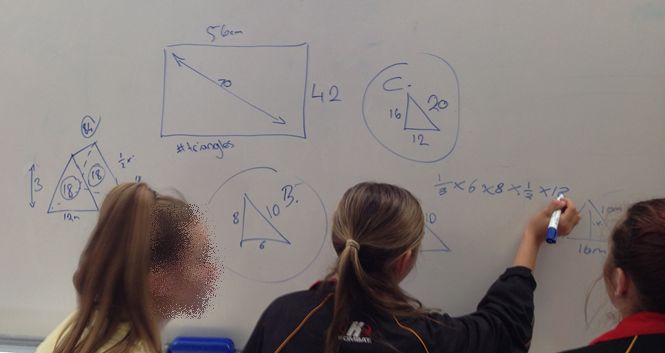
|
Student Response to the Whiteboard Room
At the end of the second excursion, students were given a brief survey where they had to tick statements with which they agreed. This is the response.
 1Comments made about sitting at a desk: Its easier to write stuff down (Year 8), I like working on my own (Year 8), My legs hurt from standing (Year 9).
1Comments made about sitting at a desk: Its easier to write stuff down (Year 8), I like working on my own (Year 8), My legs hurt from standing (Year 9).
Furthermore, independent observers took notes of student behaviour and the data showed students were more on-task and engaged in the whiteboard room than in the normal classroom.1
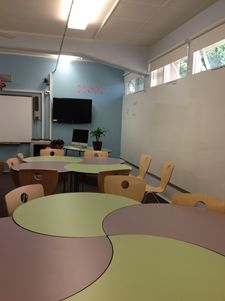
|
|
The outcome: the CLOWD Room
The data was reported back to the principal of the high school involved. Students were so taken with the concept of a whiteboard room that the school made the decision to change a room intended to be a technology hub into a room for collaborative learning, equipped not only with technology, but also with whiteboards on all walls. The name CLOWD stands for Collaborative Learners, Occupants Working Dynamically and it reflects the 21st-Century style of collaborative and cooperative learning that happens in the room. IMSITE is proud to have sponsored the room, with the assistance of the Faculty of Science, Medicine and Health, and the UOW Outreach division. The room was opened on 16 March 2015.
More rooms
The school has since installed whiteboards in five more classrooms to allow for wider use of whiteboards in daily teaching. Staff have been given PD in collaborative and cooperative teaching and as teachers engage with this philosophy, they have found they wanted to use whiteboards more regularly than once a fortnight or only at times when the CLOWD room was available.
|
|
|
|
|
Some Initial Teacher reaction
In June 2015, we took 30 practising mathematics teachers to the whiteboard room at UOW to experience it as a student. We subsequently asked for their response to the concept from both teacher and student perspectives. Here is what they said.
|
Student perspective:
|
|
Advantages
|
Disadvantages
|
Collaboration (discussion)
Ease to erase mistakes (see there problem)
Co teaching (safe learning environment)
Starting point for students that struggle
|
Self monitoring
Ideas taken away
Show thinking
Get out of seats
Work in groups
Collaborative
Seeing other work
Not boring/different
|
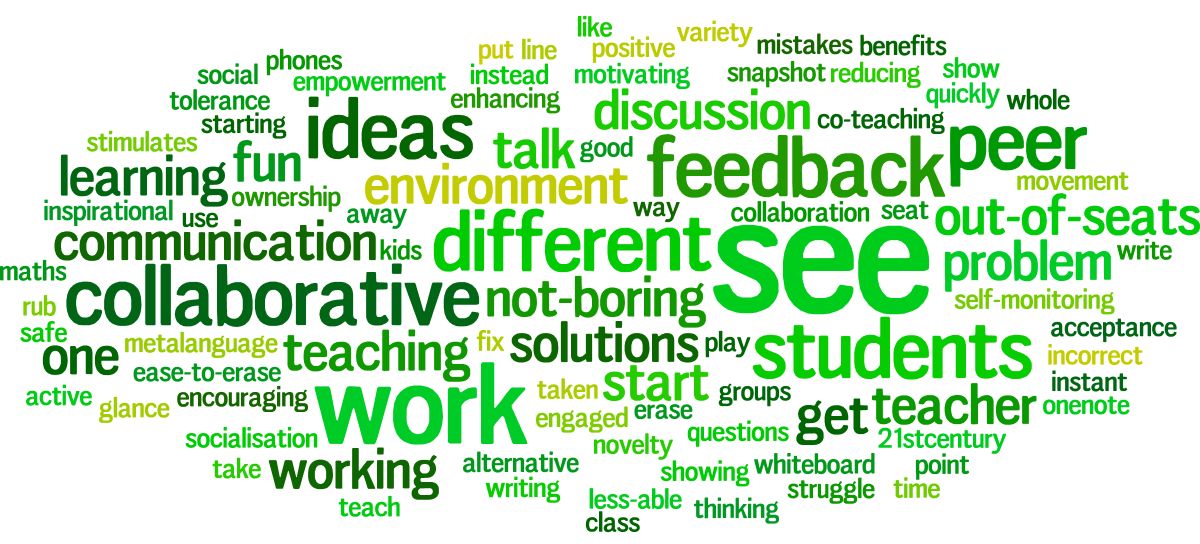
|
Different ideas and working out
Good for less able students
Write, erase & fix quickly
Stimulates discussion (peer teach)
Like writing on whiteboard
The whole class can see a variety of different solutions to one problem instead of one (teacher).
Movement (reducing seat time). Ownership of the environment.
Working collaboratively
Enhancing/Encouraging communication (social benefits).
Active
Engaged
Collaborative/communication
Use metalanguage
Fun
Rub out if incorrect & start again
Glance at other students work to see where to start
See alternative solutions
Take a snapshot on phones and put into Onenote.
Instant feedback for questions
Peer teaching
In line with 21st Century learning
Kids can play [happyface] (fun)
Novelty
Not boring
See others work, ideas, inspirational, motivating
Get to talk maths talk.
Socialisation
Out of seats
Showing off in a positive way.
Teacher feedback
Peer feedback
Empowerment
Teaching tolerance/acceptance
|
Shy/retiring
Reluctant participator
Anxiety
Intimidating
Can become un-new
Quiet students may find it confrontational
|
|
Teacher perspective:
|
|
Advantages
|
Disadvantages
|
Control the pace of the lesson
Quickly informally assess knowledge
Student are more engaged
Control the pace of the lesson
Student centred/content
|
Easy to differentiate
Novelty
Gives feedback
Student centred
Better outcomes
Peer tutoring
Common errors
Peer teaching
|
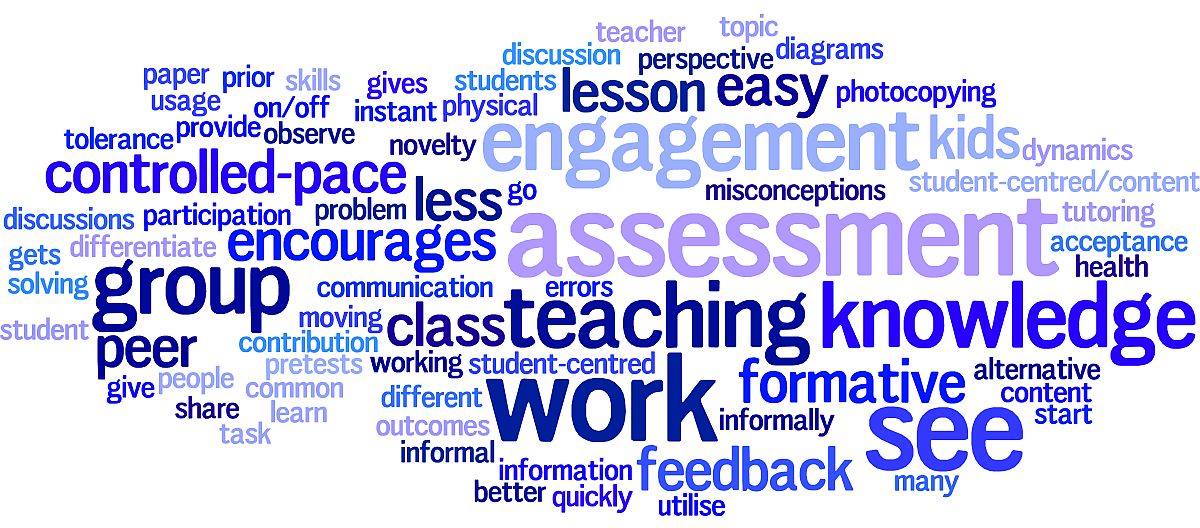
|
Provide instant feedback
See many work at once
Group work/dynamics
Gets teacher moving physical health
Teaching tolerance/acceptance
Formative assessment
Informal info from kids
Easy to observe engagement of kids
Could utilise at the start of a topic to do pretests, share prior knowledge
Formative assessment of content knowledge, communication skills, working in teams, contribution to class discussion.
See who is on/off task
Group work (less people to go to )
Less paper usage (photopying)
See class misconceptions
Encourages discussions and problem solving
See how some students learn give you a different perspective for teaching
Encourages diagrams and working
More participation/engagement
Alternative assessment
|
Location of the room and costs:
Access
Where in school?
Cost of whiteboard markers (expensive)
Setting out?
Teacher PD required:
Upskill in the structure of the room
Teachers perception
More variation in teaching
Instruction to students:
Need to teach group work/dynamics
Hard to give instruction
Making sure everyone contributes
Classroom behaviour/management:
Non-participants (student could hide)
Need more independent learners
Discipline?
Vandalism (reworded by UOW)
Can be noisy
Off task student
Kids writing inappropriate things or drawings
Noisy
Lower ability are they doing the right thing (hangman)
Seeing all groups work
Kids with bad/messy writing (embarrassment)
Not all students learn the same way
Recording student work:
Record of student work, but this isnt an issue as just assisting learning
|
|
|
|
|
Current Research
Project title:
Exploring secondary mathematics teacher perspectives of teaching and learning experiences in a whiteboard room for visible thinking.
Timing: October - December 2015
Purpose:
To investigate the teaching benefits of using rooms equipped with whiteboards on all available walls, known as whiteboard rooms, in the teaching of mathematics in a secondary school. We have a particular interest in identifying needs in the area of mathematical content and maths pedagogical knowledge. We wish to collate and report on teachers experiences in the preparation and delivery of lessons in their newly created whiteboard rooms as their regular teaching space. We intend on determining a set of pedagogical practices using data from this research with consideration to expense, student response, teacher preparation and learning benefits.
|
|
|
A brief history
|
Circa 1973. The concept of a blackboard tutorial was devised at La Trobe Universty. The room was equipped with blackboards on all walls, tables were removed from the room and students were asked to problem solve together on the boards.3
|
Late 1980's. The blackboard tutorial had gained momentum at LaTrobe and became known as the 'La Trobe method' of tutorials.3
|
1992. Blackboard tutorials introduced at UOW by Prof Sid Morris who had come from La Trobe. The style of class was used for first year subjects, and continues for all first year calculus subjects to this day.3
|

|
Current users:
La Trobe University
UOW (1992)
University of Melbourne (1994)
University of Newcastle (2012)
University of Canberra (2014)
|
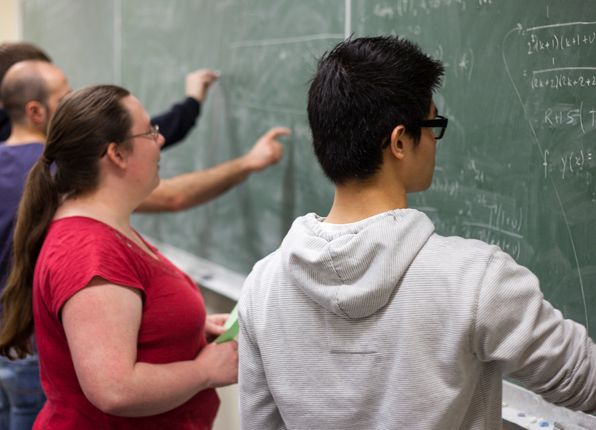
|
2003. Blackboards become whiteboards at UOW--and rooms have tables for use by other classes as there are room shortages on campus.
|
2014. Whiteboard room classes are trialled with Year 8 and Year 9 school students on an excursion to UOW. Engagement was high, collaboration was natural...
2015. The CLOWD room at Illawarra Sports High School is opened.
|
|
|
|
|
Related Links
360Degree Math
See presentations on Building Thinking classrooms by Peter Liljedahl at http://www.peterliljedahl.com/presentations
|
|
|
|
References
1 Sandison, C.E., Forrester, T., Denny, S. (2015). Work Like a Mathematician: A Study of Secondary Students Levels of Engagement Doing Maths in a Whiteboard Room, Proceedings of CoSMEd 2015, to appear.
2 Liljedahl, P. (in press). Building thinking classrooms: Conditions for problem solving. In P. Felmer, J. Kilpatrick, & E. Pekhonen (eds.) Posing and Solving Mathematical Problems: Advances and New Perspectives. New York, NY: Springer.
3 Seaton, K. A., King, D. M., & Sandison, C. E. (2014). Flipping the maths tutorial: A tale of n departments. AustMS Gazette, 41(2), 99-113.
|
|
|
|
|



